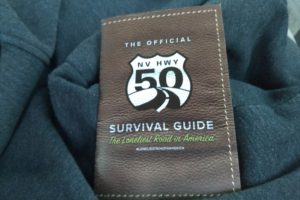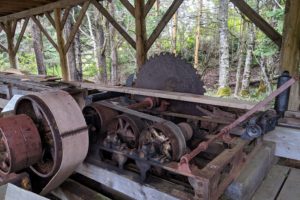After leaving Theodore Roosevelt National Park, we drove south into South Dakota on a rainy, rainy day. After being in the Badlands, the wide expanse of flat lands we drove through was pretty and boring.

If you’re a motorcycle lover, you’ve pretty heard of Sturgis, SD. I’m not, so I hadn’t. But Barney was excited to drive though this small town that becomes large for 10 days each year.
The annual Sturgis Motorcycle Rally started in 1938 when a group of Indian Motorcycle enthusiasts gathered for stunts and races. Since then the attendance has averaged around 500,000; in 2015, the attendance reached 700,000! We could see remains of where they bikers would camp, listen to music, and drink. Can you imagine the noise of all those bikes riding through town?


Wall Drug
Have you ever heard of Wall Drug? No? Then you’re in for a bit of history and fun. Let’s look at the pictures first. For miles before the town of Wall, signs like this one would be on the side of the road, like the Burma Shave signs that started in the mid-1920s.




inside





Born in 1885, Lucille began her show career when she was 14 with her father Zack Mulhall’s Wild West Show and later with the 101 Ranch Wild West Show. She could ride, wrestle a steer to the ground, and rope up to 8 running horses at a time. What a woman!






(we shared a freshly made donut that was delicious)
Since I don’t want you to miss out on the following pictures of the land around Wall, SD, I’m going to add the history of Wall Drug to the end of this post.
ridge camping
If you’ve been traveling with us for a while, you’ve caught on that I like to know how a town or area got its name. Wall Drug is in the town of Wall. So where’s the wall around here? Read on to find out.
The “wall” that gave the town its name is this ridge and its drop off that’s part of the Badlands National National Park (designated in 1978) just outside the town of Wall.
One of the full-time RVing couples we follow stayed at this location and showcased it during one of their videos. When Barney saw where they were boondocking (no electricity or water), he knew he wanted to come check out this location. We didn’t stay here over night since it was so cold and windy, but we were so glad we got to see this beautiful place.






This whole area originally came from a giant salt water sea, volcanic activity that pushed up the sea floor, and prehistoric animals that lived here (like 3-toed horses and sabre-toothed cats) and then died here—all over 30 million years ago.
About 1 to 4 million years ago, erosion began to outpace the deposits from the prehistoric animals, leaving spires that sometimes resembled castles. Rivers flowing eastward from the Black Hills (along with the help of wind, rain, and snow) cut into the deposits and carrying away thousands of tons of sedimentary rock. With the White River that flows through the area today, this erosion still continues each season.
This steeply eroded land next to the ridge isn’t able to support plant life from deep-rooted shrubs or trees could have taken hold to keep the land from further erosion. The wind and rain have blown away the layers of deposits so that what’s left is hard sandstone. The landscape now looks like it has great castles, the wall we’re standing by, and other craggy features.
This “wall” separating the lower and upper prairie areas is a rugged strip of land a 1/2 mile to 3 miles wide.
The lower prairie area along the floodplain of the White River is a sod-covered expanse with scattered buttes.
The upper prairie varies from great grassy flats to gentle grassy undulations.
nearby bighorn sheep
We saw the lower prairie area in the previous pictures. The rich land in the upper prairie in the following pictures is where crops are grown and animal can graze.



Much of the total area of the Badlands is level and fertile, covered with native grasses. Most of this land was homesteaded years ago. Some of the settlers’ descendants still live on the ranches and run good-sized herds of cattle and sheep that do so well on the native grasses that ranchers rarely need to buy other feeds. With enough rain, wheat makes a good-high quality crop.
history of Wall Drug
Ed Hustead graduated from pharmacy school in 1929, and after 2 years of working for other druggists, he and his wife, Dorothy, knew they wanted to strike out on their own. They searched all over South Dakota and Nebraska looking for a small town that needed a pharmacist and had its own Catholic church so they could go to mass every day. In the town of Wall, all of their desires were met, and they moved there with their young son, Billy, making their home at the back of the drug store.
The first few months went by and business didn’t improve. With Dorothy encouraging them both, they gave themselves 5 years to turn around their business since the monument at Mount Rushmore west of them was almost done and it would bring in tourists.
By the summer of 1936, their business hadn’t grown much at all, and their 5-year trial was almost to an end. One hot July afternoon, Dorothy tried to take a nap with the children but soon came outside to join Ted because the noise from all the cars going by on Route 16A (that didn’t go through town) was keeping her awake.
That was when she realized that they could offer ice cold water to travelers as a way to bringing people to their store. Signs along the highway, like the Burma Shave signs that started in the mid-1920s, would advertise this free ice water. In fact her first few lines were “Get a soda . . . Get root beer . . . Turn next corner . . . Just as near . . . to highway 16 & 14 . . . Free Ice Water . . . Wall Drug.”
A local school boy helped Ted build 12 x 36-inch board signs that had each phrase printed on it, and the next weekend they spaced out the signs along the highway so travelers could easily read them. By the time Ted got back to the store from putting up the signs, people had already started showing up for their ice water. And then a family asked if they could fill up their jug since they were driving all the way to Yellowstone Park. And then people started asking for ice cream cones too. For hours people came in frazzled from the heat and left refreshed and ready for new adventures, always giving the couple their thanks.
The next summer they hired 8 girls to help them out, and eventually 20,000 people would come on a good summer day. Today an estimated 5000 glasses of ice water are given away every day during the summer. Wall Drug is still a family-owned and run business that gives friendly service to the public.
Now one of my bucket list items is checked off! On to my next South Dakota bucket list item.




